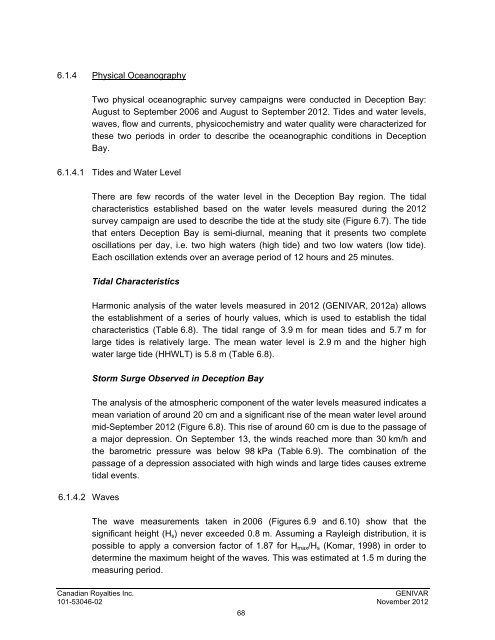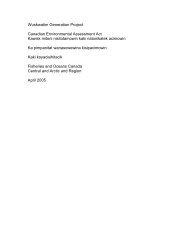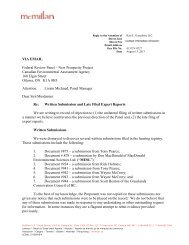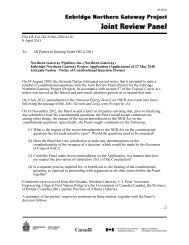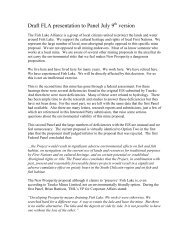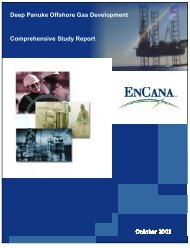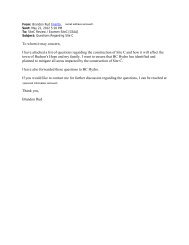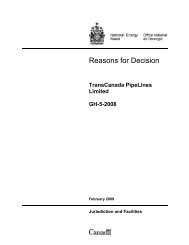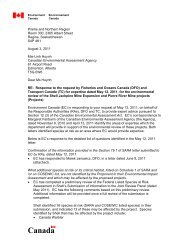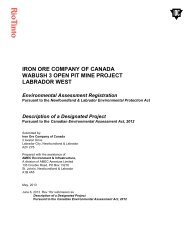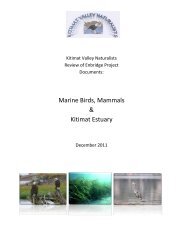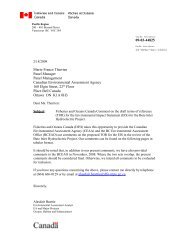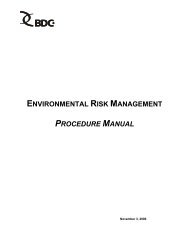- Page 1:
Environmental and Social Impact Ass
- Page 5:
NOTE TO THE READER THIS DOCUMENT IS
- Page 8 and 9:
PROJECT TEAM (CONT.) Inuits Collabo
- Page 10 and 11:
TABLE OF CONTENTS (cont.) Page 3.3
- Page 12 and 13:
TABLE OF CONTENTS (cont.) Page 6.1.
- Page 14 and 15:
TABLE OF CONTENTS (cont.) Page 7.3
- Page 17 and 18:
LIST DES TABLES Page Table 3.1 Anal
- Page 19:
LIST DES TABLES (Cont.) Page Table
- Page 23:
LISTE DES MAPS Page Map 2.1 Study A
- Page 27:
LIST OF APPENDICES VOLUME 2 (CONTIN
- Page 31:
LIST OF ACRONYMS Nunavik Inuit Land
- Page 34 and 35:
assessment on the temporary wharf,
- Page 36 and 37:
For the region north of the 55 th p
- Page 39 and 40:
2. STUDY AREA 2.1 Generalities The
- Page 41:
Arctic Island Neptune Island 74°40
- Page 44 and 45:
A score ranging from 1 to 3 was giv
- Page 46 and 47:
3.3 Disposal Sites for Dredged Sedi
- Page 49: Table 3.2 Variance analysis - Terre
- Page 52 and 53: 4.2 Public Consultations and Other
- Page 54 and 55: 4.2.1 Public consultations carried
- Page 56 and 57: to keep the young students motivate
- Page 58 and 59: landholding corporation. The people
- Page 60 and 61: the connection between these events
- Page 62 and 63: • Land use: impacts on relations
- Page 64 and 65: Meetings were held in Salluit on Se
- Page 66 and 67: To meet these objectives, a sedimen
- Page 69 and 70: 5.1.5 Bathymetric Surveys Bathymetr
- Page 71: 6 74°50'0"W 74°45'0"W 74°40'0"W
- Page 75 and 76: In 2007, two distinct sampling meth
- Page 77: 5.3 Human Environment The data and
- Page 80 and 81: Figure 6.2 Lithology of the study s
- Page 82 and 83: 6.1.2.2 Stratigraphic Context and S
- Page 85: 400 irsugaarjuk / nage Arm Xstrata
- Page 88 and 89: All long the shoreline, both in its
- Page 90 and 91: Groundwater inflow mainly occurs du
- Page 92 and 93: 6.1.3 Climate According to the Qué
- Page 94 and 95: The snow accumulations generally ar
- Page 96 and 97: Figure 6.5 Freeze-up and break-up d
- Page 98 and 99: Table 6.6 Anticipated warming of te
- Page 102 and 103: Table 6.8 Deception Bay tide table
- Page 104 and 105: Figure 6.9 Recorded series of the s
- Page 106 and 107: Figure 6.11 Current speeds measured
- Page 108 and 109: Drifters During the campaign of Aug
- Page 111 and 112: Table 6.12 Displacement speeds of d
- Page 113 and 114: Table 6.15 Descriptive statistics o
- Page 115 and 116: Figure 6.14 Canadian Sediment Quali
- Page 117: Parameters Units Station number Det
- Page 121: Parameters Units Detection limit St
- Page 125: Parameters Units Detection limit St
- Page 129: Parameters Units Detection limit St
- Page 133 and 134: Only the zinc concentration of samp
- Page 135 and 136: Table 6.17 Typical underwater sound
- Page 137: -12 A 74°41'5"W 74°41'0"W T1-5 T1
- Page 141: Table 6.20 Epibenthic fauna invento
- Page 145: Table 6.21 Endobenthic invertebrate
- Page 149 and 150: According to Figures 6.15 and 6.16,
- Page 151 and 152:
Table 6.22 Diversity indices for th
- Page 153 and 154:
Table 6.23 Main fish species presen
- Page 155 and 156:
Table 6.24 French name English name
- Page 157:
Table 6.25 Characteristics of the m
- Page 160 and 161:
Bowhead Whale Bowhead Whales are fo
- Page 162 and 163:
In May, the Ringed Seal uses the ic
- Page 164 and 165:
Finally, the Ringed Seal and the Ha
- Page 166 and 167:
Dry Tundra Dry tundra is an open fo
- Page 168 and 169:
6.2.2.3 Avifauna Appendix 14 presen
- Page 170 and 171:
Avian Fauna Seven species are poten
- Page 172 and 173:
• employment, training, income su
- Page 174 and 175:
6.3.2.5 Kativik School Board The KS
- Page 176 and 177:
The region covered by the settlemen
- Page 178 and 179:
Education 6.3.4.2 Health According
- Page 180 and 181:
the past year, a percentage three t
- Page 182 and 183:
6.3.4.5 Economic Context Economic S
- Page 184 and 185:
note that most of these jobs are he
- Page 186 and 187:
Frequentation of the Deception Bay
- Page 189 and 190:
Table 6.30 List of the main wildlif
- Page 191 and 192:
Détroit d' Hudson Hudson Strait 74
- Page 193:
Table 1 of the integration study (A
- Page 196 and 197:
7.1.2 Permanent wharf The proposed
- Page 199:
A 74°41'15"W 74°41'0"W 74°40'45"
- Page 202 and 203:
As shown on the general development
- Page 205 and 206:
e provided by two ramps arranged at
- Page 207 and 208:
First, considering only the tide ef
- Page 209 and 210:
7.1.8 Geotechnical considerations S
- Page 211 and 212:
Figure 7.1 - Permanent Dock Facilit
- Page 213 and 214:
Figure 7.3 - Transfer points Exampl
- Page 215:
A 74°40'45"W 10 Ponceau / Culvert
- Page 218 and 219:
Thus, the width of the manoeuvring
- Page 220 and 221:
The sediment disposal site will be
- Page 222 and 223:
A sampling point, before the culver
- Page 224 and 225:
7.8 Required equipment It should be
- Page 226 and 227:
Ecosystem value A component's ecosy
- Page 228 and 229:
8.1.2 Duration/intensity associatio
- Page 230 and 231:
Table 8.4 Grid for assessing the ef
- Page 232 and 233:
The structure of the data sheets is
- Page 234 and 235:
Table 8.5 Identification of potenti
- Page 236 and 237:
Data sheet PI-1 Environmental compo
- Page 238 and 239:
Data sheet PI-3 Environmental compo
- Page 240 and 241:
Equipment • Use an environmental
- Page 242 and 243:
Data sheet PI-6 Environmental compo
- Page 244 and 245:
Data sheet PI-7 Environmental compo
- Page 246 and 247:
Data sheet PI-8 Environmental compo
- Page 248 and 249:
Data sheet PI-9 Environmental compo
- Page 250 and 251:
Data sheet PI-10 Environmental comp
- Page 252 and 253:
Environmental component Avian fauna
- Page 254 and 255:
Data sheet PI-13 Environmental comp
- Page 256 and 257:
Data sheet PI-15 Environmental comp
- Page 258 and 259:
Data sheet PI-17 Environmental comp
- Page 260 and 261:
Data sheet PI-19 Environmental comp
- Page 262 and 263:
Data sheet PI-20 Environmental comp
- Page 264 and 265:
Data sheet PI-21 Environmental comp
- Page 266 and 267:
Table 8.6 Identification of potenti
- Page 268 and 269:
Data sheet DT-2 Environmental compo
- Page 270 and 271:
Environmental component Avian fauna
- Page 272 and 273:
Data sheet DT-6 Environmental compo
- Page 274 and 275:
Data sheet DT-8 Environmental compo
- Page 276 and 277:
8.3 Principal issues In this projec
- Page 278 and 279:
Moosehead Islands 74°40'0"W Projet
- Page 280 and 281:
Ship travel in the bay is likely to
- Page 282 and 283:
or caribou. With the proposed mitig
- Page 284 and 285:
8.6 Cumulative effects 8.6.1 Legal
- Page 286 and 287:
Xstrata port infrastructures Potent
- Page 288 and 289:
In Deception Bay, the potential cum
- Page 290 and 291:
Previously, it was determined that
- Page 292 and 293:
• Ensure that the bathymetry of t
- Page 294 and 295:
9.2.1.1 Follow-up of Suspended Soli
- Page 296 and 297:
CRI shall ensure that the results a
- Page 298 and 299:
AFFAIRES AUTOCHTONES ET DÉVELOPPEM
- Page 300 and 301:
COMMISSION SCOLAIRE KATIVIK, 2012.
- Page 302 and 303:
ENVIRONNEMENT CANADA. 2002a. Guide
- Page 304 and 305:
GENIVAR, 2007b. Projet Nunavik Nick
- Page 306 and 307:
INSTITUT NATIONAL DE SANTÉ PUBLIQU
- Page 308 and 309:
McCAULEY, R.D., FEWTRELL, J., DUNCA
- Page 310 and 311:
RÉGIE RÉGIONALE DE LA SANTÉ ET D
- Page 312 and 313:
STANTEC, 2012. GEOTECHNICAL REPORT


